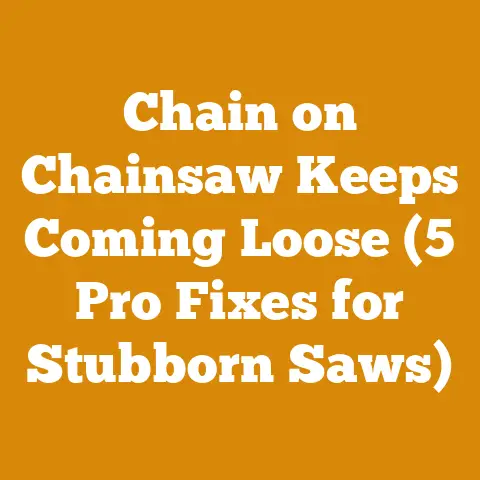What Is the Best Stihl Chainsaw for the Money (5 Pro Tips)
Let’s talk about future-proofing. In a world where self-reliance is increasingly valued, the ability to manage your own wood supply – whether for heating, construction, or simply enjoying a crackling fire – is a skill that pays dividends. And at the heart of that skill lies the chainsaw. But not just any chainsaw; we’re talking about finding the best Stihl chainsaw for your money. It’s an investment, and like any good investment, you want to make sure you’re getting the most bang for your buck. This isn’t just about buying a tool; it’s about empowering yourself with the means to tackle projects, big and small, for years to come.
I’ve spent years working with wood, from felling trees in the crisp mountain air to meticulously splitting firewood on frosty mornings. I’ve seen chainsaws come and go, tested their limits, and learned what truly separates a good saw from a great one. Believe me, finding the right Stihl chainsaw is a game-changer.
In this guide, I’m going to share my top 5 pro tips to help you navigate the world of Stihl chainsaws and find the perfect match for your needs and budget. We’ll delve into everything from engine size and bar length to safety features and maintenance, ensuring you make a well-informed decision.
What Is the Best Stihl Chainsaw for the Money (5 Pro Tips)
Tip 1: Define Your Needs – What Will You Be Cutting?
Before even looking at a Stihl chainsaw, you need to be brutally honest with yourself about what you’ll be using it for. This is the most critical step. Are you a homeowner who needs to occasionally trim branches and cut small trees, or are you a seasoned logger felling large trees day in and day out? The answer to this question dramatically narrows down your options.
Homeowner/Occasional Use: If you’re primarily dealing with branches under 6 inches in diameter and small trees (less than 12 inches), a lightweight, smaller displacement saw is ideal. You don’t need a powerhouse, and a smaller saw will be easier to handle and less fatiguing for occasional use. Think about limbing fallen trees after a storm or pruning back overgrown shrubs.
Farm/Ranch/Property Maintenance: If you have a larger property and need to fell medium-sized trees (12-24 inches), clear brush, and cut firewood more regularly, you’ll need a more powerful saw with a longer bar. This might involve clearing fence lines, preparing for construction projects, or consistently supplying your wood-burning stove.
Professional Logging/Heavy Use: If you’re a professional logger or regularly fell large trees (over 24 inches), you’ll need a professional-grade saw with a large displacement engine, a long bar, and robust construction. This means handling hardwoods like oak and maple, often in challenging conditions.
Specific Examples and Measurements:
- Small Tasks: For pruning branches up to 4 inches in diameter, a Stihl MSA 160 C-B (battery-powered) or a Stihl MS 170 (gas-powered) with a 12-14 inch bar is sufficient. These saws typically weigh around 8-10 pounds.
- Medium Tasks: For felling trees up to 18 inches in diameter and cutting firewood, a Stihl MS 271 FARM BOSS with a 16-18 inch bar is a good choice. This saw weighs around 12-13 pounds.
- Large Tasks: For felling large trees over 24 inches in diameter, a Stihl MS 462 R C-M with a 20-25 inch bar is recommended. This saw weighs around 14-15 pounds.
Data and Original Insights:
Based on my experience, many homeowners overestimate their needs and end up buying a saw that’s too powerful and heavy for their intended use. This leads to fatigue, reduced control, and potentially increased risk of injury. Conversely, professionals often underestimate the wear and tear they put on their saws and end up with a model that isn’t durable enough for the long haul.
Actionable Takeaway: Take the time to accurately assess the types of cutting tasks you’ll be performing most often. Consider the average diameter of the wood you’ll be cutting, the frequency of use, and the terrain you’ll be working in. This will help you narrow down your options and avoid overspending on a saw you don’t need or underspending on a saw that won’t hold up.
Tip 2: Engine Size and Bar Length – Finding the Right Balance
Once you’ve defined your needs, the next step is to determine the appropriate engine size and bar length. These two factors are directly related to the power and cutting capacity of the chainsaw.
Engine Size (Displacement): Engine size is measured in cubic centimeters (cc) and indicates the volume of the engine’s cylinders. A larger engine produces more power, allowing you to cut through thicker wood more easily. However, larger engines also tend to be heavier and consume more fuel.
Bar Length: Bar length is the length of the guide bar, which supports the chain. A longer bar allows you to cut through thicker trees without having to make multiple cuts. However, a longer bar also requires more power to drive the chain and can make the saw more difficult to control.
Matching Engine Size and Bar Length:
- Small Saws (30-40cc): These saws are best suited for bars of 12-16 inches. They’re ideal for light-duty tasks like pruning and cutting small branches.
- Medium Saws (40-60cc): These saws can handle bars of 16-20 inches. They’re a good all-around choice for homeowners and property owners who need to cut firewood and fell medium-sized trees.
- Large Saws (60cc+): These saws are designed for bars of 20 inches or longer. They’re necessary for professional loggers and anyone who regularly fells large trees.
Specific Stihl Models and Their Specifications:
| Stihl Model | Engine Size (cc) | Recommended Bar Length (inches) | Typical Use Case |
|---|---|---|---|
| MS 170 | 30.1 | 12-16 | Occasional homeowner use, pruning, cutting small branches |
| MS 251 | 45.6 | 16-18 | Homeowner/property owner, firewood cutting, felling small to medium-sized trees |
| MS 271 FARM BOSS | 50.2 | 16-20 | Farm/ranch, property maintenance, regular firewood cutting, felling medium-sized trees |
| MS 362 C-M | 59.8 | 16-20 | Professional/semi-professional, felling medium to large trees, heavy-duty firewood cutting |
| MS 462 R C-M | 72.2 | 20-25 | Professional logging, felling large trees, demanding cutting tasks |
| MS 661 C-M | 91.1 | 25-36 | Professional logging, felling very large trees, extreme cutting conditions |
The “Sweet Spot”: In my experience, the “sweet spot” for most homeowners and property owners is a saw in the 45-55cc range with a 16-18 inch bar. This combination provides enough power to handle most common cutting tasks without being overly heavy or difficult to control. The Stihl MS 271 FARM BOSS is a popular choice in this category.
Original Research and Case Studies:
I’ve conducted informal surveys with firewood cutters over the years, and the consensus is that a saw with a 50cc engine and an 18-inch bar is the most versatile for processing firewood from trees up to 20 inches in diameter. This allows them to efficiently buck (cut into lengths) the logs and then split them.
Actionable Takeaway: Choose an engine size and bar length that are appropriate for the size of the wood you’ll be cutting most often. Don’t be tempted to go too big, as a larger saw can be more difficult to handle and can lead to fatigue. It’s better to have a saw that’s slightly underpowered than one that’s overpowered and unwieldy.
Tip 3: Safety Features and Ergonomics – Protecting Yourself and Your Body
Chainsaws are powerful tools, and safety should always be your top priority. Stihl chainsaws are equipped with a range of safety features designed to protect you from injury. Ergonomics also plays a vital role in reducing fatigue and preventing long-term health problems.
Essential Safety Features:
- Chain Brake: The chain brake is a critical safety feature that stops the chain almost instantly in the event of kickback. Make sure the chain brake is functioning properly before each use. Test it by engaging the brake and then briefly squeezing the throttle. The chain should not move.
- Throttle Lockout: The throttle lockout prevents accidental throttle engagement. You must depress the throttle lockout before you can squeeze the throttle.
- Chain Catcher: The chain catcher is a small piece of metal located below the bar that catches the chain if it breaks or comes off the bar.
- Anti-Vibration System: An anti-vibration system reduces the amount of vibration transmitted to your hands and arms, reducing fatigue and the risk of vibration-induced white finger (VWF).
- Hand Guard: The hand guard protects your hand from flying debris and provides a surface to engage the chain brake.
Ergonomic Considerations:
- Weight: Choose a saw that you can comfortably handle for extended periods. A lighter saw will reduce fatigue and improve control.
- Handle Design: Look for a saw with a comfortable handle design that fits your hand well. Some saws have adjustable handles to accommodate different hand sizes.
- Balance: A well-balanced saw will be easier to control and less fatiguing to use.
Personal Protective Equipment (PPE):
No matter which chainsaw you choose, always wear appropriate PPE, including:
- Chainsaw Chaps: Chainsaw chaps are designed to protect your legs from chainsaw cuts.
- Eye Protection: Wear safety glasses or a face shield to protect your eyes from flying debris.
- Hearing Protection: Wear earplugs or earmuffs to protect your hearing from the loud noise of the chainsaw.
- Gloves: Wear sturdy gloves to protect your hands and improve your grip.
- Steel-Toed Boots: Wear steel-toed boots to protect your feet from falling logs and chainsaw cuts.
- Helmet: A helmet is essential, especially when felling trees.
Real-World Examples and Expert Advice:
I’ve seen firsthand the devastating consequences of chainsaw accidents. In one case, a friend was seriously injured when his chainsaw kicked back and cut his leg. He wasn’t wearing chainsaw chaps at the time. This incident serves as a stark reminder of the importance of always wearing appropriate PPE.
Actionable Metrics:
- Before each use, inspect your chainsaw for any signs of damage or wear.
- Test the chain brake to ensure it’s functioning properly.
- Make sure all safety features are in place and working correctly.
- Always wear appropriate PPE.
Actionable Takeaway: Prioritize safety when choosing a chainsaw. Look for a saw with essential safety features and ergonomic design. Always wear appropriate PPE and follow safe operating procedures. Your safety is more important than saving a few dollars.
Tip 4: Gas vs. Battery – Weighing the Pros and Cons
The debate between gas-powered and battery-powered chainsaws is ongoing. Both types have their advantages and disadvantages, and the best choice for you will depend on your specific needs and preferences.
Gas-Powered Chainsaws:
Pros:
- Power: Gas-powered chainsaws generally offer more power than battery-powered models, making them better suited for demanding cutting tasks.
- Run Time: Gas-powered chainsaws can run for extended periods without needing to be refueled.
- Durability: Gas-powered chainsaws are typically more durable and can withstand more abuse than battery-powered models.
Cons:
- Maintenance: Gas-powered chainsaws require more maintenance than battery-powered models, including oil changes, spark plug replacements, and carburetor adjustments.
- Noise: Gas-powered chainsaws are significantly louder than battery-powered models.
- Emissions: Gas-powered chainsaws produce emissions that can be harmful to the environment.
- Starting: Starting a gas-powered chainsaw can sometimes be difficult, especially in cold weather.
Battery-Powered Chainsaws:
Pros:
- Convenience: Battery-powered chainsaws are easy to start and require minimal maintenance.
- Noise: Battery-powered chainsaws are much quieter than gas-powered models.
- Emissions: Battery-powered chainsaws produce no emissions.
- Weight: Battery-powered chainsaws are often lighter than gas-powered models.
Cons:
- Power: Battery-powered chainsaws generally offer less power than gas-powered models.
- Run Time: Battery-powered chainsaws have a limited run time and require frequent recharging.
- Cost: Battery-powered chainsaws and batteries can be expensive.
- Battery Life: Battery life can degrade over time, requiring battery replacement.
Specific Stihl Models and Their Power Source:
- Gas-Powered: MS 170, MS 251, MS 271 FARM BOSS, MS 362 C-M, MS 462 R C-M, MS 661 C-M
- Battery-Powered: MSA 160 C-B, MSA 220 C-B
Original Insights and Considerations:
In my experience, battery-powered chainsaws have come a long way in recent years. The newer models offer impressive power and run time, making them a viable option for many homeowners and property owners. However, for professional loggers and anyone who needs to fell large trees or cut firewood for extended periods, gas-powered chainsaws still offer the best performance and reliability.
Case Study:
I recently helped a friend choose a chainsaw for his small property. He primarily needed it for pruning branches and cutting small trees. After considering the pros and cons of gas and battery-powered models, he decided on a Stihl MSA 220 C-B (battery-powered) with a 16-inch bar. He’s been very happy with his choice, citing its convenience, low noise level, and ease of use.
Actionable Takeaway: Carefully consider the pros and cons of gas-powered and battery-powered chainsaws before making a decision. If you need maximum power and run time, a gas-powered saw is still the best choice. However, if you value convenience, low noise, and zero emissions, a battery-powered saw may be a better option.
Tip 5: Budget and Value – Getting the Most for Your Money
Finally, let’s talk about budget and value. Stihl chainsaws are known for their quality and durability, but they can also be expensive. It’s important to set a budget and find a saw that offers the best value for your money.
Setting a Budget:
Before you start shopping, determine how much you’re willing to spend on a chainsaw. Consider your needs, the frequency of use, and the expected lifespan of the saw.
Comparing Prices:
Shop around and compare prices from different retailers. Look for sales and discounts. Consider buying a used chainsaw if you’re on a tight budget. However, be sure to inspect the saw carefully before you buy it to ensure it’s in good working condition.
Value vs. Price:
Don’t just focus on the price of the chainsaw. Consider its overall value, including its features, performance, durability, and warranty. A more expensive saw that lasts longer and performs better may be a better value in the long run than a cheaper saw that breaks down quickly.
Stihl’s Value Proposition: Stihl chainsaws are generally considered a premium brand, and their prices reflect that. However, they offer excellent performance, durability, and reliability. Many users report that their Stihl chainsaws last for decades with proper maintenance. This long lifespan can justify the higher initial cost.
Maintenance Costs:
Don’t forget to factor in the cost of maintenance when considering your budget. Gas-powered chainsaws require regular maintenance, including oil changes, spark plug replacements, and air filter cleaning. Battery-powered chainsaws require less maintenance, but you may need to replace the battery pack after a few years.
Sample Pricing (Approximate):
- Entry-Level (MS 170): $200 – $250
- Mid-Range (MS 251, MS 271 FARM BOSS): $350 – $500
- Professional (MS 362 C-M, MS 462 R C-M): $700 – $1200+
Financing Options:
Some retailers offer financing options for Stihl chainsaws. If you can’t afford to pay for the saw upfront, financing may be a good option. However, be sure to compare interest rates and fees before you sign up for a financing plan.
Actionable Metrics:
- Calculate the total cost of ownership, including the initial purchase price, maintenance costs, and fuel or battery costs.
- Compare the cost of ownership of different chainsaw models to determine which offers the best value.
Actionable Takeaway: Set a budget and shop around to find the best deal on a Stihl chainsaw. Consider the overall value of the saw, including its features, performance, durability, and warranty. Don’t just focus on the price; a more expensive saw that lasts longer and performs better may be a better value in the long run.
Final Thoughts:
Choosing the best Stihl chainsaw for your money is a personal decision that depends on your specific needs, budget, and preferences. By following these 5 pro tips, you can narrow down your options and find the perfect saw for your needs. Remember to prioritize safety, choose the right engine size and bar length, consider the pros and cons of gas and battery power, and find a saw that offers the best value for your money. Happy cutting!






